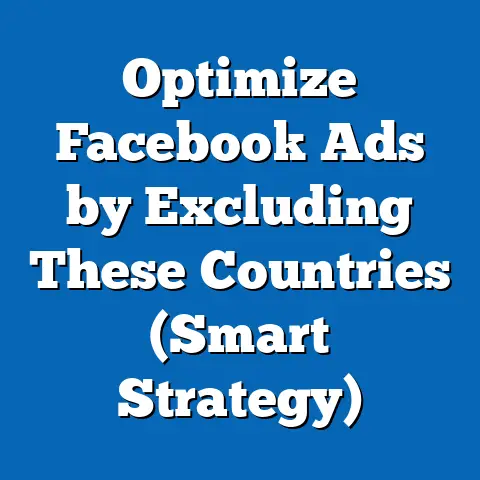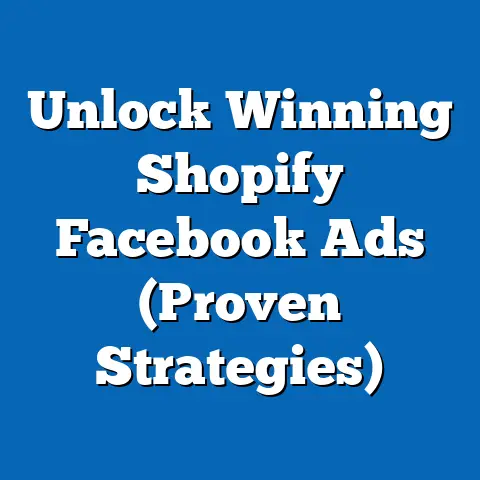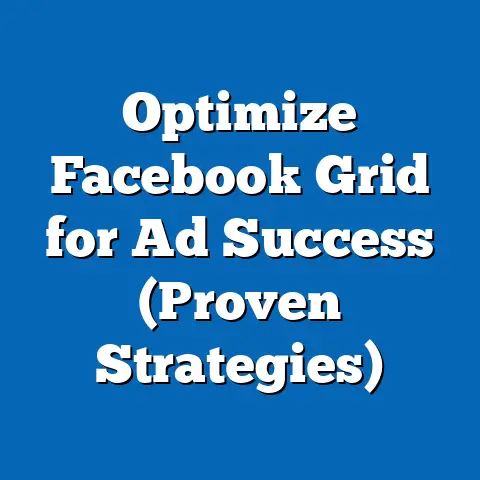Master Facebook Ad API (Unlock Campaign Success)
In the ever-evolving landscape of digital marketing, businesses and advertisers are presented with an unprecedented opportunity to harness the power of data-driven advertising through platforms like the Facebook Ad API (Application Programming Interface). This tool, part of Meta’s broader suite of advertising solutions, allows developers and marketers to programmatically manage and optimize advertising campaigns on an unparalleled scale, tapping into one of the largest social media audiences globally—over 3 billion monthly active users as of 2023 (Statista, 2023).
The opportunity lies in leveraging the API’s capabilities to create hyper-targeted, automated, and scalable campaigns that drive measurable results. Unlike traditional advertising methods or even manual management through Facebook’s Ads Manager, the API offers a level of precision and efficiency that can transform how brands connect with consumers.
Defining the Facebook Ad API: Core Characteristics and Functionality
The Facebook Ad API, part of the Meta Marketing API suite, is a programmatic interface that enables developers and advertisers to create, manage, and analyze advertising campaigns directly through code. Unlike the user-friendly interface of Facebook Ads Manager, the API is designed for automation, allowing businesses to handle large-scale campaigns, integrate with third-party tools, and access advanced features not available through manual methods.
Key characteristics include its ability to support bulk campaign creation, real-time optimization, and detailed performance analytics. It allows for dynamic ad content updates, audience segmentation based on granular data, and integration with Customer Relationship Management (CRM) systems or other marketing platforms. This level of control is particularly valuable for enterprises managing thousands of ads across multiple markets or for agencies handling diverse client portfolios.
Moreover, the API supports a wide range of advertising objectives, from brand awareness to lead generation and e-commerce conversions. Its flexibility makes it a cornerstone for businesses aiming to maximize return on investment (ROI) in a competitive digital advertising landscape. However, it requires technical expertise, as interacting with the API demands knowledge of programming languages like Python or JavaScript and familiarity with API documentation.
Historical Context: The Evolution of Digital Advertising and the Rise of APIs
To fully appreciate the significance of the Facebook Ad API, it is essential to understand the broader historical context of digital advertising. The late 1990s and early 2000s marked the dawn of online advertising with banner ads and rudimentary pay-per-click (PPC) models on platforms like Google AdWords. These early methods were largely untargeted, relying on broad demographics and limited user data.
The launch of Facebook in 2004 and its subsequent introduction of advertising in 2007 revolutionized the industry by leveraging user-generated data—interests, behaviors, and social connections—to deliver personalized ads. By 2012, with the release of the Facebook Ads API (initially under restricted access), businesses could programmatically tap into this data, marking a shift toward automation and scalability in advertising.
This period also coincided with the rise of social media as a cultural and economic force, with platforms becoming central to consumer engagement. The API’s evolution reflects broader trends in technology, such as the growth of big data, machine learning, and cloud computing, which enabled real-time ad optimization and audience targeting at scale. Significant events like the 2018 Cambridge Analytica scandal, which exposed data privacy concerns, also shaped the API’s development, leading Meta to impose stricter access controls and transparency requirements.
Today, the Facebook Ad API stands as a product of over two decades of digital advertising innovation, embodying the shift from manual, intuition-based marketing to automated, data-driven strategies. Its historical trajectory underscores its role as a critical tool in navigating the complexities of modern consumer behavior.
Societal Implications: Transforming Marketing and Beyond
The widespread adoption of the Facebook Ad API has far-reaching implications for society, influencing not just marketing but also consumer behavior, privacy norms, and economic structures. At its core, the API enables hyper-personalized advertising, which can enhance user experiences by delivering relevant content but also raises ethical questions about surveillance and manipulation.
One significant societal impact is the democratization of advertising. Small businesses and individual entrepreneurs can now compete with larger corporations by using API-driven tools to target niche audiences cost-effectively. This levels the playing field, fostering innovation and economic opportunity, particularly in emerging markets where digital advertising spend is growing rapidly—projected to reach $701 billion globally by 2027 (eMarketer, 2023).
However, this personalization comes at the cost of privacy concerns. The API relies on vast amounts of user data, and incidents like data breaches or misuse have heightened public scrutiny. Regulatory frameworks such as the General Data Protection Regulation (GDPR) in Europe and the California Consumer Privacy Act (CCPA) in the U.S. have emerged to address these issues, impacting how advertisers use the API and forcing Meta to adapt with features like Limited Data Use (LDU) settings.
Culturally, the API contributes to the shaping of consumer trends by amplifying viral content and influencer marketing. It enables brands to respond to cultural shifts in real time, but it also risks reinforcing echo chambers by targeting users with content that aligns with their existing beliefs. This duality highlights the need for ethical guidelines in API usage to balance commercial goals with societal well-being.
Technological Factors: The Backbone of API-Driven Advertising
The success of the Facebook Ad API is deeply tied to advancements in technology that enable its functionality. At the forefront is the role of big data, which powers the API’s ability to segment audiences based on demographics, interests, behaviors, and even real-time location data. This granular targeting is supported by machine learning algorithms that optimize ad delivery, predict user engagement, and adjust bidding strategies dynamically.
Cloud computing also plays a critical role, allowing businesses to process vast datasets and manage campaigns without significant on-premises infrastructure. Integration with other technologies, such as CRM platforms (e.g., Salesforce) and data management platforms (DMPs), further enhances the API’s utility by enabling seamless data flow across marketing ecosystems.
However, technological barriers exist. The API’s complexity requires skilled developers and robust systems, which can exclude smaller businesses lacking resources. Additionally, Meta’s frequent updates to the API—often driven by policy changes or new features—demand continuous learning and adaptation from users. Despite these challenges, the technological foundation of the API positions it as a cornerstone of modern digital marketing, with innovations like AI-driven creative optimization on the horizon.
Economic Factors: Driving ROI in a Competitive Landscape
Economically, the Facebook Ad API offers significant advantages by enabling cost-efficient campaign management and higher ROI. Automation reduces labor costs associated with manual ad creation and monitoring, while real-time bidding and optimization ensure budget allocation to high-performing ads. For instance, studies show that businesses using API-driven automation can achieve up to a 30% reduction in cost-per-acquisition (CPA) compared to manual methods (WordStream, 2022).
However, economic disparities influence API adoption. Larger enterprises with dedicated tech teams can fully leverage its capabilities, while smaller businesses may struggle with implementation costs or lack of expertise. Additionally, the competitive nature of digital advertising means that API users must continuously innovate to maintain an edge, as ad fatigue and rising costs-per-click (CPC)—up 14% year-over-year in 2023 (Tinuiti, 2023)—pose ongoing challenges.
Social and Cultural Influences: Shaping Consumer Engagement
The social and cultural context in which the Facebook Ad API operates significantly impacts its effectiveness. Social media platforms like Facebook and Instagram (both accessible via the API) are cultural hubs where trends, memes, and movements emerge and spread. The API allows advertisers to tap into these cultural currents by delivering timely, relevant content—think of brands leveraging viral challenges or holiday themes to engage users.
Generational differences also play a role. Younger audiences, such as Gen Z (born 1997–2012), prioritize authenticity and social impact, often responding better to ads from brands that align with their values. In contrast, older demographics like Baby Boomers (born 1946–1964) may prioritize trust and clarity in messaging. The API’s targeting capabilities enable tailored approaches to these diverse groups, but marketers must avoid stereotyping and recognize the heterogeneity within each cohort.
Culturally, the API’s global reach requires sensitivity to regional norms and languages. A campaign that resonates in North America may fall flat or offend in Asia-Pacific markets if not adapted appropriately. Thus, while the API offers powerful tools for social engagement, its success depends on cultural intelligence and a nuanced understanding of audience dynamics.
Generational Dynamics in API-Driven Advertising
Understanding generational dynamics is critical to mastering the Facebook Ad API, as each cohort interacts with digital advertising differently. Gen Z, for instance, is highly active on Instagram and values visual, short-form content like Stories and Reels—formats the API can target with precision. Their tech-savviness also means they are more likely to use ad blockers or ignore overt marketing, necessitating creative, value-driven campaigns.
Millennials (born 1981–1996), often in their peak earning years, are a key demographic for e-commerce and lifestyle brands. They respond well to personalized offers and social proof (e.g., reviews), which the API can deliver through dynamic ads and retargeting. However, their growing concern for data privacy—spurred by high-profile scandals—means transparency in ad practices is essential.
Gen X (born 1965–1980) and Baby Boomers, while less digitally native, are increasingly active on Facebook, with 70% of U.S. adults over 50 using the platform (Pew Research, 2023). They often prioritize utility and trust, making clear calls-to-action and brand reputation critical in API-driven campaigns targeting these groups. Across all generations, the API’s ability to segment and personalize offers a pathway to relevance, but it requires a deep understanding of each cohort’s values and behaviors.
Workplace Implications: Redefining Marketing Roles and Skills
The adoption of the Facebook Ad API is reshaping the marketing workplace by prioritizing technical skills and data literacy. Traditional marketers accustomed to creative roles must now collaborate with developers and data analysts to design API-driven campaigns. This shift is evident in the growing demand for roles like “Marketing Technologist,” with job postings for API-related skills up 25% since 2020 (LinkedIn, 2023).
For organizations, the API offers efficiency gains but also necessitates investment in training and tools. Agencies, for instance, can manage multiple clients more effectively using automation, but they must balance this with maintaining personalized client relationships. Smaller teams may outsource API management to third-party platforms like Hootsuite or Sprinklr, which integrate with Meta’s systems, though this adds cost.
The API also fosters a data-driven culture in workplaces, where decisions are based on metrics rather than intuition. While this can enhance accountability, it risks over-reliance on numbers at the expense of creativity—a balance that modern marketing teams must strike to remain competitive.
Nuances and Diversity in API Application
While the Facebook Ad API offers powerful capabilities, its application is not one-size-fits-all. Industries like e-commerce benefit immensely from dynamic product ads and retargeting, whereas B2B sectors may focus on lead generation through forms and LinkedIn integrations (also accessible via Meta’s ecosystem). The API’s effectiveness depends on aligning its features with specific business goals and audience needs.
Diversity in user expertise also matters. Advanced users can build custom solutions using the API’s full potential, such as automated rules for budget allocation or machine learning models for predictive targeting. In contrast, beginners may rely on pre-built integrations or partner tools, limiting their scope but still achieving results. Meta’s tiered access levels—Standard, Advanced, and Preferred—further reflect this diversity, with higher tiers unlocking more features for qualified partners.
Geographic and regulatory differences add another layer of complexity. In regions with strict data laws, such as the EU, API users must navigate compliance challenges like user consent for tracking. These nuances underscore that while the API is a powerful tool, its success hinges on tailored, context-aware implementation.
Quantitative and Qualitative Insights: Measuring Success
Quantitative data underscores the API’s impact on campaign performance. Businesses using API automation report a 20–40% increase in ad efficiency, measured by metrics like click-through rates (CTR) and conversion rates (Meta Business, 2023). Real-time reporting, accessible via the API, also enables rapid iteration—crucial in a landscape where ad relevance can decay within days.
Qualitatively, case studies highlight the API’s transformative potential. For example, a mid-sized e-commerce brand using API-driven dynamic ads saw a 50% uplift in sales during a holiday campaign by automatically showcasing products users had previously viewed (Shopify, 2022). Agencies report improved client satisfaction due to faster campaign adjustments and transparent reporting, fostering trust.
However, qualitative feedback also reveals challenges, such as the steep learning curve for non-technical teams and frustration with Meta’s evolving policies (e.g., iOS 14.5 tracking changes impacting attribution). Combining quantitative metrics with qualitative insights provides a holistic view of the API’s value and areas for improvement.
Forward-Looking Insights: The Future of API-Driven Advertising
Looking ahead, the Facebook Ad API is poised to evolve with emerging technologies and shifting societal norms. The integration of artificial intelligence (AI) will likely enhance predictive targeting and creative generation, with Meta already piloting tools like Advantage+ campaigns that automate ad creation. Augmented reality (AR) ads, accessible via the API, could also redefine engagement, especially for younger audiences on Instagram.
Privacy regulations will continue to shape the API’s trajectory. As third-party cookies phase out and user consent becomes paramount, Meta may pivot toward first-party data solutions or contextual targeting, requiring API users to adapt. The rise of the metaverse, Meta’s long-term vision, could also integrate advertising in virtual spaces, opening new frontiers for API applications.
Economic uncertainties, such as inflation or recession risks, may influence ad budgets, pushing businesses to rely even more on API-driven efficiency. However, the competitive saturation of digital advertising means innovation will be critical—those who master the API’s advanced features will likely lead the market.
Uncertainty remains around user trust and platform policies. Will consumers accept increasingly personalized ads, or will backlash grow? How will Meta balance advertiser needs with regulatory demands? These questions highlight the dynamic nature of API-driven advertising and the need for agility among its users.
Conclusion: Unlocking Campaign Success with Strategic Mastery
Mastering the Facebook Ad API represents a transformative opportunity for advertisers to achieve campaign success in a data-driven, hyper-connected world. Its defining characteristics—automation, scalability, and precision—make it a powerful tool for businesses of all sizes, while its historical roots in the evolution of digital advertising underscore its significance. Societally, it reshapes consumer engagement and economic opportunity but demands careful navigation of privacy and ethical concerns.
By understanding the technological, economic, social, and cultural factors influencing its use, marketers can unlock the API’s full potential while addressing generational and contextual nuances. The workplace is evolving alongside this technology, prioritizing new skills and data-driven decision-making, though challenges like complexity and cost remain.
As we look to the future, the API’s role will likely expand with innovations like AI and AR, even as privacy and economic pressures introduce uncertainty. For now, success lies in strategic mastery—leveraging the API’s capabilities with creativity, cultural sensitivity, and a commitment to ethical advertising. In doing so, businesses can not only drive ROI but also contribute to a digital ecosystem that balances commercial goals with societal good.






